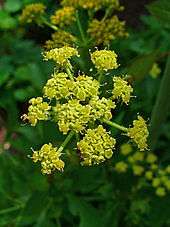Lovage
| Lovage | |
|---|---|
| | |
| Scientific classification | |
| Kingdom: | Plantae |
| (unranked): | Angiosperms |
| (unranked): | Eudicots |
| (unranked): | Asterids |
| Order: | Apiales |
| Family: | Apiaceae |
| Tribe: | Apieae |
| Genus: | Levisticum Hill |
| Species: | L. officinale |
| Binomial name | |
| Levisticum officinale W.D.J.Koch | |
Lovage (/ˈlʌvᵻdʒ/), Levisticum officinale, is a tall perennial plant, the sole species in the genus Levisticum in the family Apiaceae, subfamily Apioideae, tribe Apieae.[1][2]
Description

Lovage is an erect, herbaceous, perennial plant growing to 1.8–2.5 m (5.9–8.2 ft) tall, with a basal rosette of leaves and stems with further leaves, the flowers being produced in umbels at the top of the stems. The stems and leaves are shiny glabrous green to yellow-green and smell somewhat similar to celery when crushed. The larger basal leaves are up to 70 cm (28 in) long, tripinnate, with broad triangular to rhomboidal, acutely pointed leaflets with a few marginal teeth; the stem leaves are smaller, and less divided with few leaflets. The flowers are yellow to greenish-yellow, 2–3 mm (0.079–0.118 in) diameter, produced in globose umbels up to 10–15 cm (3.9–5.9 in) diameter; flowering is in late spring. The fruit is a dry two-parted schizocarp 4–7 mm (0.16–0.28 in) long, mature in autumn.[3][4][5]
Distribution
The exact native range is disputed; some sources cite it as native to much of Europe and southwestern Asia,[6] others from only the eastern Mediterranean region in southeastern Europe and southwestern Asia,[3] and yet others only to southwestern Asia in Iran and Afghanistan, citing European populations as naturalised.[4][7] It has been long cultivated in Europe, the leaves being used as an herb, the roots as a vegetable, and the seeds as a spice, especially in southern European cuisine.[3]
Properties and uses
The leaves can be used in salads, or to make soup or season broths, and the roots can be eaten as a vegetable or grated for use in salads. Its flavor and smell is somewhat similar to celery. The seeds can be used as a spice, similar to fennel seeds.[3] In the UK, an alcoholic lovage cordial is traditionally mixed with brandy in the ratio of 2:1 as a winter drink.[8] In Romania, the leaves are the preferred seasoning for the various local broths, much more so than parsley or dill.
The roots, which contain a heavy, volatile oil, are used as a mild aquaretic.[9] Lovage root contains furanocoumarins which can lead to photosensitivity.[10]
Etymology

The name "lovage" is from "love-ache", ache being a medieval name for parsley; this is a folk-etymological corruption of the older French name levesche, from late Latin levisticum, in turn thought to be a corruption of the earlier Latin ligusticum, "of Liguria" (northwest Italy), where the herb was grown extensively.[11] In modern botanical usage, both Latin forms are now used for different (but closely related) genera, with Levisticum for (culinary) lovage, and Ligusticum for Scots lovage, a similar species from northern Europe, and for related species.[4][11] In Germany and the Netherlands, one of the common names of lovage is Maggikraut (German) or Maggiplant (Dutch) because the plant's taste is reminiscent of Maggi soup seasoning;[12] however, the classic German name is Liebstöckel, which is literally translated as "love stick".[13] Italian levistico or sedano di monte, French livèche, Romanian leuştean, Hungarian lestyán, Russian любисток lyubeestok, etc. In Bulgaria, it is known as девесил deveseel. The Czech name is libeček, and the Polish name is lubczyk, both meaning "love herb". The name in Swedish is libbsticka, Norwegian løpstikke. The Croatian name for this plant is ljupčac or vegeta (named after a well-known Croatian meal seasoning similar to Maggi); the Finnish name is liperi or lipstikka, the former meaning "preacher's collar", because in old ages the plant was cultivated in monasteries or in rectories, while the latter is from Swedish, which is the second language spoken in Finland.
References
- ↑ Pimenov, M. G., and Leonov, M. V. (1993). The Genera of the Umbelliferae. Royal Botanic Gardens, Kew. ISBN 0-947643-58-3.
- ↑ Downie, S. R., Plunkett, G. M., Watson, M. F., Spalik, K., Katz-Downie, D. S., Valiejo-Roman, C. M., Terentieva, E. I., Troitsky, A. V., Lee, B.-Y., Lahham, J., and El-Oqlah, A. (2001). "Tribes and clades within Apiaceae subfamily Apioideae: the contribution of molecular data". Edinburgh Journal of Botany 58: 301–330. doi:10.1017/s0960428601000658.
- 1 2 3 4 Huxley, A., ed. (1992). New RHS Dictionary of Gardening. ISBN 0-333-47494-5.
- 1 2 3 Blamey, M. & Grey-Wilson, C. (1989). Illustrated Flora of Britain and Northern Europe. ISBN 0-340-40170-2.
- ↑ Interactive Flora of NW Europe: Levisticum officinale (Lovage)
- ↑ Den virtuella floran: Levisticum officinale (Swedish), with map
- ↑ Germplasm Resources Information Network: Levisticum officinale
- ↑ Information on Lovage Cordial
- ↑ "Community herbal monograph on Levisticum officinale Koch, radix" (pdf). European Medicines Agency. 2012-03-27. Retrieved 2015-07-28.
- ↑ Ashwood-Smith MJ, Ceska O, Yeoman A, Kenny PG. (May 1993). "Photosensitivity from harvesting lovage (Levisticum officinale).". Contact Dermatitis. 26 (5): 356–7. doi:10.1111/j.1600-0536.1992.tb00138.x. PMID 1395606.
- 1 2 Oxford English Dictionary
- ↑ Udo Pini. Das Gourmet Handbuch. ISBN 978-3-8480-0584-0.
- ↑ Source: http://www.dict.cc/?s=Liebst%C3%B6ckel See also German Wikipedia article
External links
 Media related to Levisticum officinale at Wikimedia Commons
Media related to Levisticum officinale at Wikimedia Commons
| ||||||